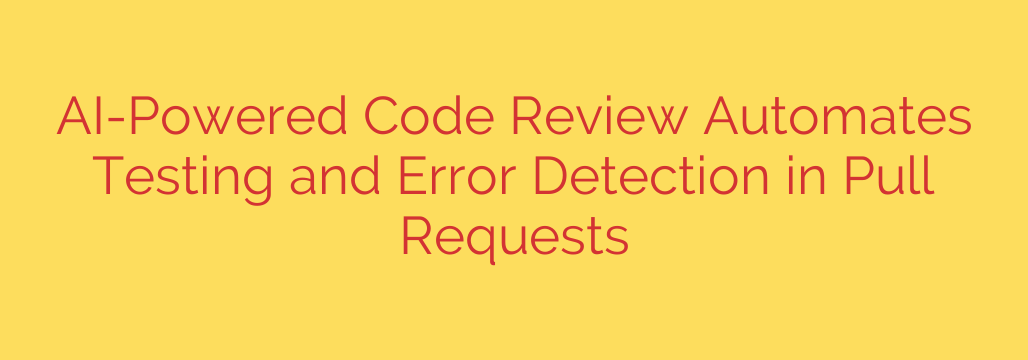
The Future of Code Review: Leveraging AI for Smarter, Faster Pull Requests
The pull request (PR) is a cornerstone of modern software development, serving as the critical gatekeeper for code quality, collaboration, and stability. However, as development cycles accelerate, the traditional, manual code review process often becomes a significant bottleneck. Teams face challenges with inconsistent feedback, reviewer fatigue, and the ever-present risk of human error allowing subtle bugs or security flaws to slip into production.
Fortunately, a new wave of innovation is transforming this landscape. Artificial intelligence is now being integrated directly into the development workflow, automating key aspects of code review to make the process faster, more accurate, and more secure than ever before. These AI-powered tools act as a tireless assistant for development teams, analyzing every line of code before a human reviewer even sees it.
The Problem with Purely Manual Reviews
Manual code reviews, while essential, have inherent limitations. Senior developers spend countless hours on routine checks for style inconsistencies, potential null pointer exceptions, and other common mistakes. This not only slows down the entire development pipeline but also pulls experienced engineers away from more complex architectural challenges.
Furthermore, the quality of a manual review can vary depending on the reviewer’s expertise, workload, and even the time of day. This inconsistency can lead to friction within teams and an unpredictable level of code quality.
How AI is Revolutionizing the Pull Request
AI-powered code review tools integrate directly with platforms like GitHub, GitLab, and Bitbucket to automatically scan pull requests as soon as they are created. By leveraging machine learning models trained on millions of open-source and proprietary code repositories, these systems can identify issues with remarkable accuracy.
Here are the key benefits of integrating AI into your code review process:
Automated Bug and Error Detection: AI excels at spotting common programming errors, potential race conditions, resource leaks, and logic flaws that are easy for the human eye to miss. It can instantly flag issues that could lead to runtime crashes or unexpected behavior, providing developers with immediate feedback to fix them before the code is merged.
Enhanced Security Scanning: Security is no longer an afterthought. AI tools can act as a first line of defense, automatically detecting common security vulnerabilities like SQL injection, cross-site scripting (XSS), and insecure data handling. This proactive approach helps mitigate risks early in the software development lifecycle (SDLC), long before they become critical threats.
Ensuring Code Quality and Consistency: Maintaining a consistent coding style across a large team is a constant challenge. AI tools can enforce style guides and best practices automatically, checking for proper formatting, naming conventions, and code complexity. This frees human reviewers to focus on the more critical aspects of the PR, such as the overall logic and architectural soundness.
Accelerating Development Cycles: By catching errors instantly, AI dramatically reduces the back-and-forth between developers and reviewers. This leads to shorter review times, faster merge cycles, and a more efficient CI/CD pipeline. Developers can ship features more quickly without sacrificing quality or security.
Actionable Security and Implementation Tips
Adopting AI in your workflow doesn’t have to be an all-or-nothing proposition. Here are a few practical steps to get started:
Start with a Pilot Project: Introduce an AI code review tool on a single, non-critical project to evaluate its effectiveness. This allows your team to get comfortable with the technology and customize its rules to fit your specific needs.
Integrate, Don’t Dictate: The best AI tools supplement human expertise, they don’t replace it. Use the AI’s feedback as a preliminary check to handle routine issues. This empowers senior developers to focus their valuable time on complex logic, architectural decisions, and mentoring.
Customize the Ruleset: Out-of-the-box configurations are a great starting point, but most tools allow for customization. Tune the analysis to align with your organization’s specific coding standards, security requirements, and performance benchmarks.
Prioritize Security Alerts: Pay close attention to the security vulnerabilities flagged by the AI. Treat these alerts with high priority and ensure developers understand the nature of the threat and the proper remediation steps.
A Co-Pilot for Every Developer
The integration of AI into code review isn’t about removing developers from the equation; it’s about augmenting their capabilities. By automating the tedious and error-prone aspects of code analysis, these intelligent tools empower teams to build more robust, secure, and reliable software at a faster pace. As this technology continues to evolve, it is set to become an indispensable part of every high-performing engineering organization.
Source: https://www.helpnetsecurity.com/2025/09/24/sentry-ai-code-review/








